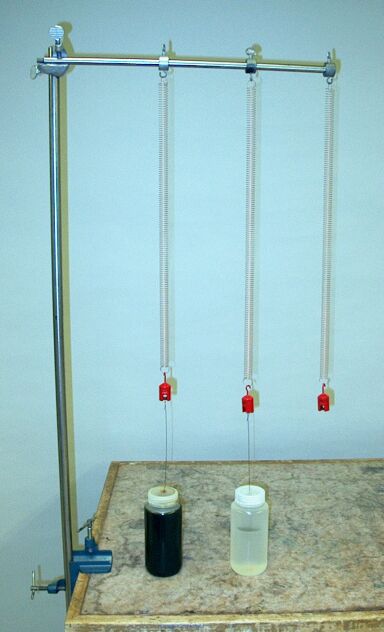
A video of this demonstration is available at this link.
The mass-spring at right oscillates freely, with minimal damping. Each of the other mass-springs is connected to a dashpot, which provides damping. The fluid in the dashpot for the mass-spring at left is heavy motor oil, which provides overdamping; when you displace the mass, it takes a long time for it to return to its equilibrium position. The dashpot on the middle mass-spring is filled with water, which provides damping that is quite close to critical damping. When you displace the mass, it returns relatively quickly to its equilibrium position and stops there with little or no oscillation.
Demonstration 40.12 -- Mass-springs with different spring constants and masses, illustrates the behavior of such systems, and its web page describes it mathematically. Application of Hooke’s Law yields an equation of motion that is a second-order differential equation (m(d2x/dt2) + kx = 0). Its solution gives the displacement of the mass from its equilibrium position, on the axis along which the mass-spring oscillates, as x = A cos (ωt - φ), where A, the amplitude of oscillation, is the maximum displacement, and φ is a phase factor. Both A and φ depend on how the motion begins.
This demonstration has three mass-spring systems, two of which are connected to dashpots, which provide damping. The damping force is proportional to the velocity of the mass, and it adds a term to the equation of motion for the mass-spring system, which is now
m(d2x/dt2) + c(dx/dt) + kx = 0
The characteristic equation that corresponds to this is mr2 + cr + k = 0. The roots to this equation are [-c ±√(c2 - 4mk)]/2m. If we divide the equation by m, substitute 2b for c/m, and substitute ω2 for k/m, the equation becomes
(d2x/dt2) + 2b(dx/dt) + ω2x = 0,
and the roots become r1 = -b + √(b2 - ω2) and r2 = -b - √(b2 - ω2). This gives rise to three different situations, depending on the relative sizes of b and ω:
1) If b2 - ω2 > 0, the system is said to be overdamped (or overcritically damped). The roots are real and unequal, and both are negative. The solution of the differential equation above is:
x = C1er1t + C2er2t.
Since both r1 and r2 are negative, x approaches zero as time increases. Depending on the conditions, the mass may cross the equilibrium position once, but no more than once, and the system does not oscillate. The mass-spring damped in oil, which does not oscillate, and which takes a long time to reach equilibrium when the mass is displaced, is an example of an overdamped system.
2) If b2 - ω2 = 0, the system is said to be critically damped. The roots are equal, and the solution of the differential equation is:
x = (C1t + C2)e-ωt (or x = (C1t + C2)e-bt).
As time increases, x approaches zero (but does not cross it). (The mass also approaches the equilibium position more quickly than it does when the system is overdamped.) The mass-spring damped in water, which after the mass is displaced, rather quickly approaches equilibrium with little or no overshoot or oscillation, exhibits the behavior of a system that is critically damped. Critical damping has important practical application, perhaps most notably in the suspensions of cars. At each wheel, the car rests on a spring, with a strut or shock absorber mounted either inside or next to the spring. The strut or shock absorber, which is a piston that rides inside a fluid-filled cylinder – similar to a dashpot – is designed to provide critical damping so that when the car goes over a bump, the wheel and fender return to their equilibrium position quickly, without oscillating.
3) If b2 - ω2 < 0, the system is said to be underdamped. In this case, the roots are complex and unequal. If we let ω2 - b2 = α2, the roots are r1 = -b + αi and r2 = -b - αi. This leads to the solution
x = e-bt(C1 cos αt + C2 sin αt).
If we set C1 = A cos φ and C2 = A sin φ (where A = √(C12 + C22) and tan φ = C2/C1), we can use the trigonometric identity
A cos(αt - φ) = A cos φ cos αt + A sin φ sin αt
to obtain
x = Ae-bt cos (αt - φ)
This equation describes damped oscillation. This is similar to simple harmonic motion whose frequency, in radians per second, is α, and whose period is T = 2π/α, except that the amplitude is not constant. Because of the factor e-bt, which is called the damping factor, the amplitude (which equals Ae-bt), decays over time. As noted above, b, in the damping factor, equals c/(2m). The greater the damping force (friction), the larger b is, and the more quickly the oscillations decay. We can see from the equation above, that the displacement of the mass oscillates between the two curves x = Ae-bt and x = -Ae-bt.
The period of oscillation, T = 2π/α = 2π/√(ω2 - b2), is longer than that for the system in which there is no friction, for which T = 2π/ω. We can see that as friction, and thus b, becomes smaller, T approaches that for the frictionless system. Also, the damping factor approaches unity, and the equation above reduces to x = A cos (ωt - φ), the equation for the undamped mass-spring oscillator, given in the first paragraph above. The freely hanging mass-spring system, which has very little damping, is an underdamped system.
References:
1) Thomas, George B., Jr. and Finney, Ross L. Calculus and Analytic
Geometry (Reading, Massachusetts: Addison-Wesley Publishing Company,
1992), pp. 1081-1082.
2) Resnick, Robert and Halliday, David. Physics, Part One, Third
Edition (New York: John Wiley and Sons, 1977), pp. 322-323.
3) http://hyperphysics.phy-astr.gsu.edu/hbase/oscda.html#c1 and
links to related topics.